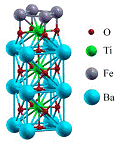Department of Physics and Astronomy: Publications and Other Research

Evgeny Tsymbal Publications
ORCID IDs
Tsymbal http://orcid.org/0000-0002-6728-5533
Document Type
Article
Date of this Version
1-29-2015
Citation
Physical Review Letters (2015) 114: 046601
doi: 10.1103/PhysRevLett.114.046601
Abstract
Electric-field control of spin-dependent properties has become one of the most attractive phenomena in modern materials research due to the promise of new device functionalities. One of the paradigms in this approach is to electrically toggle the spin polarization of carriers injected into a semiconductor using ferroelectric polarization as a control parameter. Using first-principles density-functional calculations, we explore the effect of ferroelectric polarization of electron-doped BaTiO3 (n-BaTiO3) on the spin-polarized transmission across the SrRuO3/n-BaTiO3(001) interface. Our study reveals that, in this system, the interface transmission is negatively spin polarized and that ferroelectric polarization reversal leads to a change in the transport spin polarization from −65% to −98%. Analytical model calculations demonstrate that this is a general effect for ferromagnetic-metal–ferroelectric-semiconductor systems and, furthermore, that ferroelectric modulation can even reverse the sign of spin polarization. The predicted effect provides a nonvolatile mechanism to electrically control spin injection in semiconductor-based spintronics devices.


Comments
Copyright 2015, American Physical Society. Used by permission